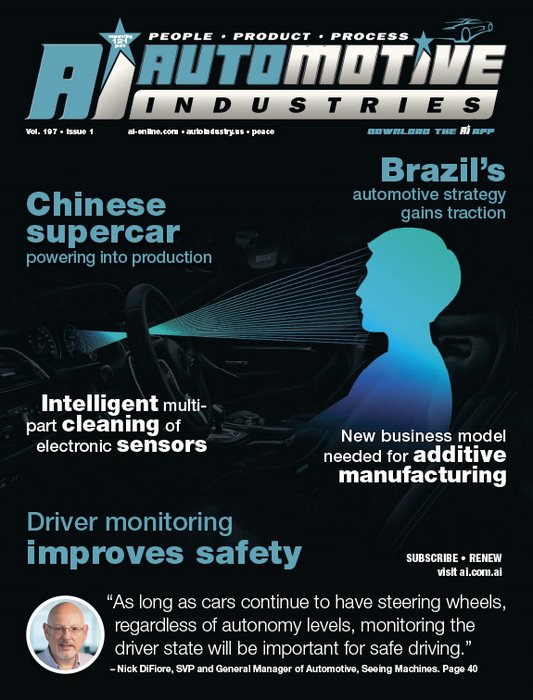
Safety bodies around the world are recommending or enforcing the inclusion of driver monitoring systems (DMS) as part of the vehicle’s safety feature, with the focus on reducing accidents related to driver fatigue or distraction.
Australia-based Seeing Machines has been researching and developing DMS technology since 2000, and has thousands of DMS units working in off-road heavy mining vehicles and onroad heavy trucks. It is the first company to supply a system for a production car, with a DMS solution in the Cadillac CT6 Super Cruise system from General Motors.
Automotive Industries (AI) asked Nick DiFiore, SVP and General Manager of Automotive, Seeing Machines, whether Driver Monitoring Systems (DMS) are gaining recognition for both driver assistance and safe autonomy.
DiFiore: As long as cars continue to have steering wheels, regardless of autonomy levels, monitoring the driver state will be important for safe driving. This is the reason why Euro NCAP has proposed DMS as a primary safety system, specifically targeting driver distraction and drowsiness. Tier 1 suppliers are becoming increasingly innovative on combining knowledge of what is happening on the road (from outward sensors) with an accurate real-time understanding of driver state using Seeing Machines’ DMS technology. With this technology Tier 1s can eliminate false or unnecessary driver warnings, and enable completely new warnings, like the vehicle knowing that you did not see the pedestrian or stop sign. We also see OEMs introducing DMS as a critical safety element in their planned Level 2 and Level 3 automated driving systems understanding that knowledge of driver state is critical to safe operation and transition of control between car and driver.
AI: Do you see the introduction of fully autonomous vehicles as a challenge to DMS?
DiFiore: Estimates on the uptake of fully autonomous vehicles range from a few years to decades. While autonomous cars will probably be introduced relatively soon in limited geofenced scenarios (e.g. taxi-like services), Seeing Machines’ view is that OEMs will build driverless functionality into some vehicles (SAE Levels 4 and 5), but these will coexist with human driven cars (SAE Levels 0 to 3) for decades to come. This is supported by Accenture, which predicts that by 2040, only four out of every 10 cars on the road will have the ability to completely self-drive. And once we do begin to reach Level 5 nirvana, the challenge has just begun for Seeing Machines as we address the need for these robots on wheels to see, understand, and assist their occupants.
AI: Is competition in the DMS segment growing?
DiFiore: We welcome the competition as it validates the direction of the market. But, we are finding most DMS technology start-ups see the driver’s face as just another machine vision or deep learning problem solved through a rather academic approach. In practice, it’s the most challenging embedded machine vision problem in the car yet. The system must be affordable, packageable, have automotive level quality and reliability, and it must be able to accurately assess a driver’s overall state at all times regardless of many complex variables, including lighting conditions, use of sunglasses, or a driver’s race or ethnicity. This requires very unique knowledge of photonics, optics, machine vision and learning, human physiology, and human psychology.
AI: Tell us about the collaboration with Autoliv.
DiFiore: Autoliv is one of the world’s leading safety system suppliers which includes ADAS. We jointly believe that a reliable understanding of driver state will enhance Autoliv’s already stellar ADAS offerings, and will also enable Autoliv to develop highly autonomous driving functions for its OEM customers, including safe hands-off-wheel operation. The two companies are working closely to pair Seeing Machines DMS with Autoliv’s ADAS and autonomy applications to enhance the driving experience, as well as promote safer driving practices. Autoliv’s LIV 2.0 vehicle which debuted this year at the Consumer Electronics Show, in Las Vegas, is an early example of the collaboration.
AI then asked Kevin Tanaka, Senior Director of Marketing, Automotive, Seeing Machines, how the company is responding to OEMs’ growing demand for safety solutions for drivers.
Tanaka: We are in constant close consultation with key automotive OEMs and Tier 1s, research institutes, government agencies and regulators to understand the needs and direction of the industry. Several of Seeing Machines’ business leaders have been in the automotive industry for over 20 years, and are active participants in the growth of electronic safety and advanced driver assistance systems. Uptake by OEMs is being accelerated by DMS being included in the Euro NCAP 2025 Roadmap and recent US NTSB (National Transportation Safety Board) reports stating that having an active driver monitoring system may help to prevent traffic accidents. Seeing Machines is constantly evaluating the latest in camera sensor, lighting, lens and coating technologies to understand performance and cost impacts, and discussing findings and potential developments with our Tier 1 and OEM customers. The company also continues to invest in Human Factors research in partnership with universities and industry to develop the scientific basis of our next generation offerings. Seeing Machines engineering also continues to develop algorithms and software that utilize our core tracking signals to provide new outputs to customers which want more granularity in understanding driver attention.
AI: How do you meet changing industry demands?
Tanaka: Our core technology continues to evolve, and is largely driven by customer demand. Every customer potentially wants a different feature set in their bespoke DMS, so we use our base Driver Monitoring Engine and refine the output signals to meet the specifications of the system being developed in conjunction with Tier 1 suppliers or to the specifications of OEM automakers. As an example, GM’s Cadillac CT6 with Super Cruise, the world’s first true production hands-free driving system for the highway, utilizes Seeing Machines’ DMS technology.
However Seeing Machines’ technology has already advanced further and our next generation DMS signal outputs already go well beyond current capabilities being used in the market. This is currently not available to consumers due to the amount of time it takes to get an automotive product into full OEM production.
AI: How will issues like driver fatigue be handled in the future?
Tanaka: Driver drowsiness is a widely accepted issue around the world and across most transport sectors. In the US, the NTSB estimates that there are over 50,000 crashes every year in which drowsiness or fatigue was cited by police as a causal factor. The American Automotive Association (AAA) Foundation for Traffic Safety has just published a new study showing that drivers behind the wheel being too tired to safely operate a motor vehicle is more widespread than previously estimated and suspects that one in 10 vehicle accidents in the U.S. is caused by drowsy drivers. Studies in other parts of the world (Europe, Australia) suggest between 18% and 44% of crashes are caused by the same. While Euro NCAP has truly set the standard with its “Road Map 2025” and DMS requirement in 2020, Japan’s Autonomous Driving Business Investigative Commission made up of Japanese OEM automakers, Tier 1s, government ministries and universities, has also announced that DMS will be necessary for all semiautonomous vehicles that may require the driver to take over from the autonomous driving system, because the driving system will need to know the driver’s attention state in order to do this.
AI: Where is DMS proven in the field?
Tanaka: Seeing Machines is entrenched in after-market solutions for commercial fleet and off-road (mining) DMS where fatigue is a notorious issue. In these markets real-time detection and intervention has already been proven to reduce fatigue and distraction related driver/operator events. One company has told us that if a DMS is not working in their heavy truck, it does not roll out that day. I think that, eventually, DMS will become a requirement for any on-road vehicle. The technical trends for [semi-] autonomous vehicles are pointing in this direction. Also, the very high costs of drowsy and distracted driving in terms of deaths and injuries is forcing a shift in the consumer mindset, and changing how government agencies, regulators and the OEMs approach this problem.

Seeing Machines’ FOVIO driver monitoring technology debuted in the GM Cadillac CT6 Super Cruise system.












More Stories
Is Your 70 Series Land Cruiser Underperforming? Here’s How to Unleash Its True Potential
What to Do After a Motorcycle Accident to Protect Yourself
Injured in a Motorcycle Crash? Talk to an Attorney Now